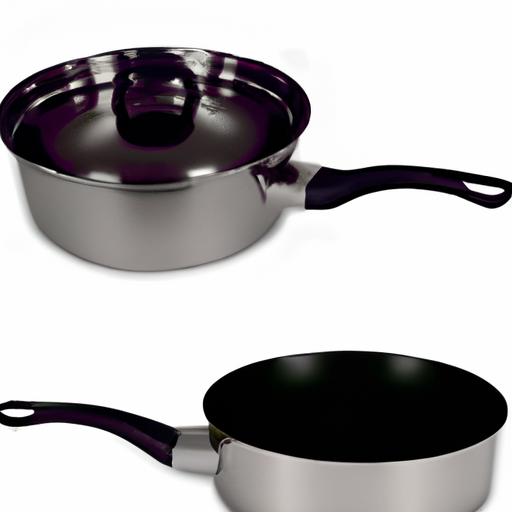Are you in need of some new cookware for your kitchen? Look no further! Tastepan.com is here to help you navigate the world of kitchen equipment and find the perfect tools for your culinary adventures. In this article, we will compare the two most popular cookware materials: stainless steel and non-stick. Whether you’re a seasoned chef or just starting out in the kitchen, understanding the pros and cons of these materials is essential for creating delicious meals with ease. Let’s dive in and learn more about the benefits and drawbacks of stainless steel and non-stick cookware.

Durability
Stainless Steel
Stainless steel is widely known for its exceptional durability. This material is highly resistant to scratches, dents, and rust, making it a long-lasting option for your cookware. With proper care, stainless steel pots and pans can withstand the test of time, staying in great condition even after years of use. This durability ensures that you can rely on your stainless steel cookware for all your cooking needs, without worrying about it wearing out or degrading.
Non-Stick
Non-stick cookware is also known for its durability, although it may not be as robust as stainless steel. The non-stick coating applied to the surface of these pans helps to prevent food from sticking, which in turn reduces the need for excessive scrubbing. While the non-stick coating may wear off over time, with proper use and care, non-stick cookware can still provide you with a decent lifespan.
Heat Conductivity
Stainless Steel
When it comes to heat conductivity, stainless steel cookware may not be as efficient as some other materials. Stainless steel is not the best at conducting heat evenly across the cooking surface, which means that you may experience hot spots or uneven cooking. However, many stainless steel pots and pans come with a layer of aluminum or copper at the base, which helps to improve heat conductivity and reduce the chances of uneven cooking.
Non-Stick
Non-stick cookware, on the other hand, often incorporates materials like aluminum, which are excellent heat conductors. This allows for even distribution of heat throughout the cooking surface, ensuring that your food cooks evenly. The non-stick coating also helps in reducing the chances of food sticking and burning, further enhancing the heat conductivity of these pans.

Heat Distribution
Stainless Steel
Similar to heat conductivity, stainless steel cookware may not provide the most even heat distribution. However, as mentioned earlier, many stainless steel pans come with a layer of aluminum or copper at the base, which helps to compensate for this drawback. This additional layer helps to distribute heat more evenly across the cooking surface, reducing the risk of unevenly cooked meals.
Non-Stick
Non-stick cookware is designed to provide excellent heat distribution. The conductive materials, such as aluminum, used in the construction of these pans help to distribute heat evenly across the surface. This ensures that your food cooks consistently and avoids any undercooked or overcooked spots. If you’re looking for cookware that can provide reliable heat distribution, non-stick options are worth considering.
Versatility
Stainless Steel
Stainless steel cookware is highly versatile and can be used for a wide range of cooking tasks. From cooking delicate sauces and melting butter to sautéing vegetables or browning meat, stainless steel pans handle it all. Their ability to withstand high heat makes them suitable for various cooking techniques, including searing and deglazing. Additionally, stainless steel cookware is often oven-safe, allowing you to start a dish on the stovetop and transfer it to the oven for finishing.
Non-Stick
Non-stick cookware is also quite versatile, although it may not be suitable for all cooking methods. These pans excel at low to medium heat cooking, making them ideal for tasks like frying eggs or flipping pancakes. However, they are not recommended for high-heat cooking or searing, as the non-stick coating can deteriorate under such conditions. While non-stick pans have their limitations, they still offer a wide range of cooking possibilities, especially for those who prefer gentler cooking methods.

Maintenance
Stainless Steel
Maintaining stainless steel cookware is relatively straightforward. These pans are typically dishwasher-safe, making cleanup a breeze. However, to maintain the stainless steel’s shine and luster, hand washing is often recommended. Stubborn stains or buildup can be removed using a mixture of water, mild detergent, and gentle scrubbing. Regularly polishing the stainless steel can help prevent long-term discoloration and maintain its appearance.
Non-Stick
Non-stick cookware requires a bit more care to preserve the integrity of the non-stick coating. These pans are generally not recommended for dishwasher use, as the harsh detergents and high water temperatures can damage the non-stick surface. Instead, it is best to hand wash non-stick cookware with a non-abrasive sponge or cloth. Avoid using metal utensils that can scratch or chip the non-stick coating, and opt for silicone, nylon, or wooden utensils instead to prolong the longevity of your non-stick pans.
Safety
Stainless Steel
Stainless steel cookware is considered safe for cooking purposes. It is a non-reactive material, which means that it does not leach any harmful chemicals or flavors into your food, even at high cooking temperatures. Stainless steel is also resistant to corrosion, eliminating the risk of rust contaminating your meals. Additionally, manufacturers often adhere to strict safety standards when producing stainless steel cookware, ensuring that it meets industry regulations and is safe for use in the kitchen.
Non-Stick
Non-stick cookware is generally safe for cooking, as long as it is used and maintained properly. The non-stick coating used in these pans is made from materials such as polytetrafluoroethylene (PTFE) or ceramic. When used within their temperature limits, these coatings do not release harmful fumes or chemicals. However, it is crucial to avoid subjecting non-stick pans to excessively high heat, as this can cause the coating to break down and release toxic fumes. Overall, by following the manufacturer’s instructions and using non-stick cookware responsibly, it can be a safe and convenient option for your kitchen.
Cooking Performance
Stainless Steel
Stainless steel cookware provides excellent cooking performance, especially when it comes to achieving a good sear. The material’s ability to distribute heat evenly enables you to brown meat or create a flavorful crust on your dishes. Stainless steel pans also excel at deglazing, allowing you to capture and incorporate the delicious flavors that come from caramelization. While stainless steel may require a bit more attention and technique to prevent sticking, it offers a great cooking experience once you become familiar with its characteristics.
Non-Stick
Non-stick cookware shines in terms of its cooking performance for low to medium heat tasks. These pans are designed to prevent food from sticking, making flipping delicate items like eggs or pancakes effortless. The non-stick coating also makes cleaning up a breeze since food particles are less likely to cling to the surface of the pan. Non-stick cookware may not provide the same searing capabilities as stainless steel, but it excels in its specialized cooking tasks, ensuring that your food cooks evenly and comes out of the pan with ease.
Cooking Surfaces
Stainless Steel
Stainless steel cookware typically has a smooth and polished cooking surface. This surface is less prone to scratches and can withstand a variety of utensils, including metal ones. The smooth surface allows for easy maneuvering of utensils and quick release of food. However, stainless steel can be a bit stickier than non-stick surfaces, particularly when cooking certain foods like eggs or delicate fish fillets. A little extra oil or butter may be needed to prevent sticking in these situations.
Non-Stick
As the name suggests, non-stick cookware boasts a cooking surface that is designed to prevent food from clinging to it. This smooth surface allows for easy food release and prevents sticking, even with minimal amounts of oil or butter. The non-stick coating provides a convenient cooking experience, especially when it comes to delicate foods or dishes that require gentle flipping or stirring. However, it is crucial to ensure that you use non-abrasive utensils and avoid cutting directly on the non-stick surface, as these actions can damage the coating.
Price
Stainless Steel
Stainless steel cookware is available at various price points, depending on the brand, quality, and construction. Higher-end stainless steel cookware sets often come with thicker layers of aluminum or copper for enhanced heat conductivity, as well as durable construction to withstand heavy use. These sets can be pricier but offer long-term value and performance. On the other hand, more budget-friendly stainless steel options are available, providing a more affordable choice without compromising on durability and functionality.
Non-Stick
Non-stick cookware is generally more budget-friendly compared to higher-end stainless steel options. The affordability of non-stick pans makes them accessible to a wide range of consumers, especially those who are on a tighter budget. While cheaper non-stick cookware may not last as long or provide the same level of performance as more expensive options, there are still durable and reliable non-stick pans available at higher price points.
Environmental Impact
Stainless Steel
Stainless steel cookware has a relatively low environmental impact. The material itself is highly recyclable, and many stainless steel pans are made from recycled materials. Additionally, stainless steel cookware’s long lifespan means that it won’t need to be replaced as frequently, reducing waste and environmental impact. Choosing stainless steel cookware can be a sustainable choice for those looking to minimize their carbon footprint and contribute to a greener planet.
Non-Stick
Non-stick cookware has a mixed environmental impact. The non-stick coating used in these pans is not recyclable, and when the coating eventually wears off, the pan may need to be disposed of. However, there are non-stick pans available with more eco-friendly coatings, such as ceramic coatings, which are free from potentially harmful chemicals. Choosing non-stick cookware with conscious and sustainable manufacturing processes can help reduce the environmental impact associated with these pans.
In conclusion, both stainless steel and non-stick cookware have their unique strengths and considerations to keep in mind. Stainless steel offers exceptional durability, versatility, and cooking performance, although it may require some know-how to prevent sticking. Non-stick cookware provides convenient cooking experiences with easy food release and effortless cleanup, although it may not be suitable for high-heat cooking or long-term durability. Ultimately, the choice between stainless steel and non-stick cookware depends on your cooking preferences, budget, and specific needs in the kitchen.

